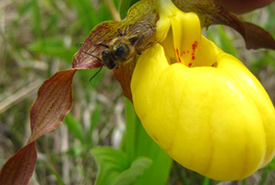Something’s Fishy: Catching up on 57 years of conservation

Dr. J. Bruce Falls, Richard Pough, Aird Lewis and Dave Fowle, first exploratory meeting for the Nature Conservancy of Canada, 1961
The Nature Conservancy of Canada (NCC) got its start in the early 1960s with four naturalists who were inspired to protect the natural world around them. Based in Ontario, this plucky band of naturalists launched a program to take direct, private...
The importance of wetlands

Sunset at Minesing Wetlands, ON (Photo by Ethan Meleg)
In the summer of 2019, I had the pleasure of working as a conservation technician for the Nature Conservancy of Canada (NCC). While I was working out of the Norfolk office in southwestern Ontario, I spent a lot of time in restored fields and...
Get to know one of Canada’s rarest snakes

Desert nightsnake (Photo by W. Mason CC BY-NC)
Working at the Nature Conservancy of Canada (NCC) has taught me many things, including the fact that many people are infatuated with snakes. Whether people are afraid of them, invested in protecting their habitats or enjoy learning about what...
Don’t trust lady’s-slippers (if you’re a bee)

This honeybee was tricked into pollinating this yellow lady’s-slipper. (Photo by Steven Anderson/NCC staff)
Before I began working at the Nature Conservancy of Canada (NCC), I spent six years studying the pollination of two species of lady’s-slipper orchids in Manitoba and the northern U.S. While I no longer spend all of my time thinking about...
Hummingbirds: The forgotten pollinator when it comes to pesticides

Female rufous hummingbird (Photo by Jennifer Kepler CC BY-NC)
When life is leaping forth in its freshest tender green and shrubs are casting their best wine-rich blooms of colour, there comes a humming. Not just from the song of spring rising in the world, but from wing beats — 52 to 62 per...
Making friends with the solitary bees

Blue orchard bee (Photo by Robert Engelhardt)
When you think of bees, your mind probably goes to honey, hives and stingers. But what if I told you that there was a species of bee, native to the Saskatchewan prairies, that didn’t make honey, live in a hive or (usually) sting? Mason bees...
Monarch migration

Monarch (Photo by NCC)
Fall is fast approaching. As the days grow shorter and temperatures drop, it’s time for monarchs to migrate south for the winter. These iconic bright-orange butterflies will soon be replaced by pumpkins and turning leaves. Monarchs spend...
Wildlife crossings: Opening the way for the good of wildlife

Wildlife crossings make roads safer. (Photo by Wikimedia Commons)
Whether in the form of bridges or tunnels, wildlife crossings make roads safer by protecting humans and animals from collisions while helping maintain the connectivity of natural environments. “Things are not always what they seem: the deer...
Point counts at Wideview: 10,000 steps by 7 a.m.

Wideview, SK (Photo by NCC)
3 a.m.: Why am I awake this early? The only other creatures awake right now are the birds. Oh, right. The birds are exactly why I’m awake this early. It’s time for point counts at the Nature Conservancy of Canada’s (NCC’s)...
Something’s Fishy: Dace of shade

Redside dace (Photo by K. Schmidt)
Fine, I’ll say it: as a redhead, I have an affinity for red-coloured species. It’s an unspoken alliance we gingers have — walking, swimming or climbing through a world where we might stand out from the crowd based on our...

